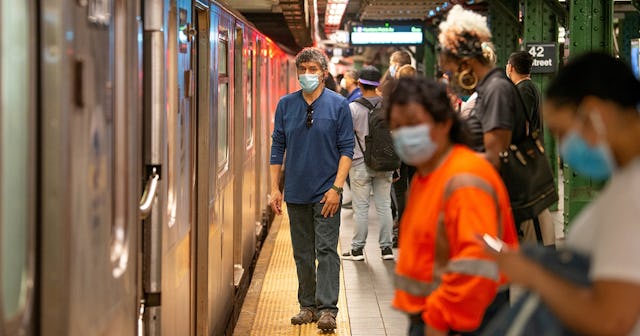WHO Now Recommends Wearing Face Masks In Areas Where Distancing Is Not Possible

The World Health Organization also recommends people over 60 wear medical masks
If you’re living in an area of “widespread transmission” of the coronavirus and you’re in a public space where social distancing is not possible, the World Health Organization (WHO) has a message for you: Wear a mask.
On Friday, WHO published updated guidance on the use of masks for the control of COVID-19. For starters, the organization recommends that the general public wear a fabric mask whenever social distancing of about three feet is not possible. This includes on public transport, in shops, or in other confined or crowded environments, says WHO’s Director-General Dr. Tedros Adhanom Ghebreyesus at a press briefing.
And, yes, this includes people who are not showing symptoms.
“In light of evolving evidence, WHO advises that governments should encourage the general public to wear masks where there is widespread transmission and physical distancing is difficult,” Ghebreyesus says.
WHO’s previous recommendations stated that the general public “only need to wear a mask if you are taking care of a person with COVID-19” or “if you are coughing or sneezing.”
WHO also now recommends the following people wear medical masks: people over 60; people with underlying comorbidities such as cardiovascular disease or diabetes mellitus, chronic lung disease, cancer, cerebrovascular disease, and immunosuppression; healthcare workers in communities with widespread transmission; and those with any COVID-19 symptoms.
As a reminder, COVID-19 symptoms can include fever, cough, fatigue, loss of appetite, shortness of breath, and muscle pain. Other non-specific symptoms such as sore throat, nasal congestion, headache, diarrhea, nausea and vomiting, have also been reported, in addition to loss of smell and taste preceding the onset of respiratory symptoms.
WHO’s updated guidance contains new information on the composition of fabric masks, as well.
According to the document, a minimum of three layers is required, depending on the fabric used. This includes an inner layer made of an absorbent material, like cotton, touching the mouth; a middle layer made of a non-woven material, like polypropylene, to act as a filter; and an outer layer made of a non-absorbent material, like polyester, exposed to the environment.
WHO also recommends washing non-medical masks frequently and handling them carefully so as to not contaminate other items.
“People can potentially infect themselves if they use contaminated hands to adjust a mask, or to repeatedly take it off and put it on, without cleaning hands in between,” Ghebreyesus stresses. “Masks can also create a false sense of security, leading people to neglect measures such as hand hygiene and physical distancing.”
WHO says masks alone are “insufficient” at providing an “adequate level of protection or source control,” and that people should also wash their hands or use hand sanitizer, maintain physical distancing of at least one meter (or just over 3 feet), refrain from touching their mouth, nose, and eyes, and cover their nose and mouth when coughing or sneezing.
“I cannot say this clearly enough: Masks alone will not protect you from COVID-19,” Ghebreyesus says. “Masks are not a replacement for physical distancing, hand hygiene and other public health measures. Masks are only of benefit as part of a comprehensive approach in the fight against COVID-19.”